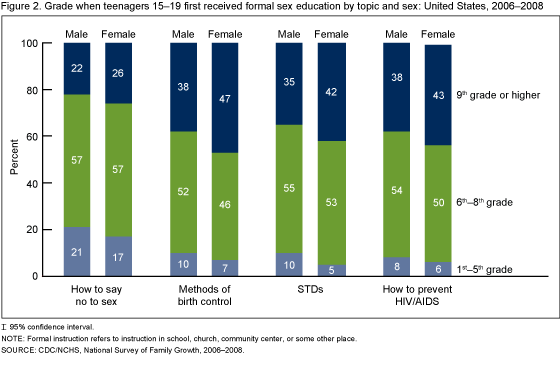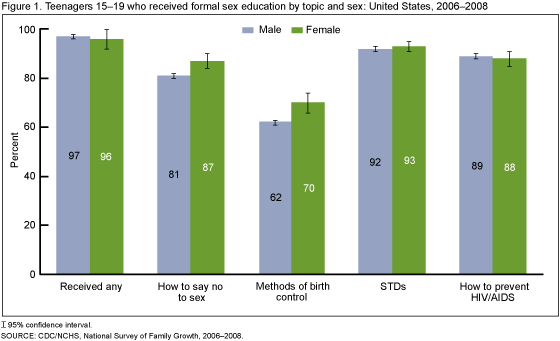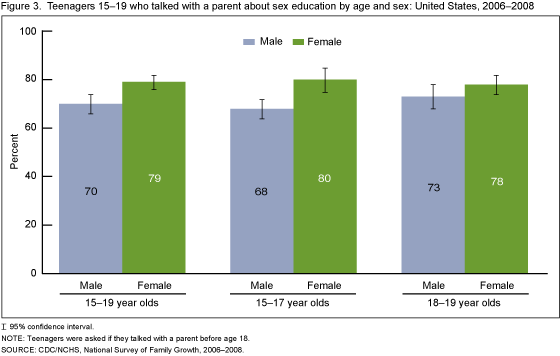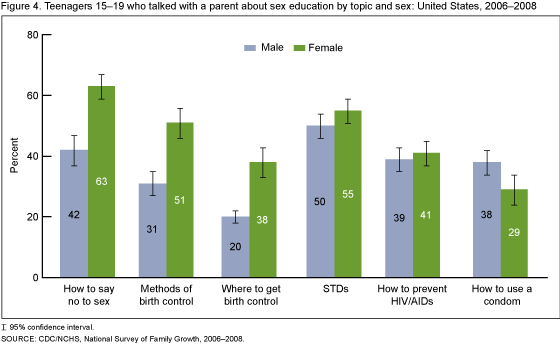Educating Teenagers About Sex in the United States
On This Page
- Key findings
- What percentage of teenagers received formal sex education?
- What grade are teenagers in when they first receive formal sex education?
- Do teenagers talk about sex-related topics with their parents?
- Do male and female teenagers differ in whether they talk to their parents about sex and birth control?
- Summary
- Definitions
- Data soure and methods
- About the authors
- References
- Suggested citation
NCHS Data Brief No. 44, September 2010
PDF Version (1.0 MB)
Gladys Martinez, Ph.D.; Joyce Abma, Ph.D.; and Casey Copen, Ph.D.
Key findings
Data from the National Survey of Family Growth
- Most teenagers received formal sex education before they were 18 (96% of female and 97% of male teenagers).
- Female teenagers were more likely than male teenagers to report first receiving instruction on birth control methods in high school (47% compared with 38%).
- Younger female teenagers were more likely than younger male teenagers to have talked to their parents about sex and birth control.
- Nearly two out of three female teenagers talked to their parents about “how to say no to sex” compared with about two out of five male teenagers.
Sex education in schools and other places, as well as received from parents, provides adolescents with information to make informed choices about sex at a crucial period of their development. Using data from the 2006-2008 National Survey of Family Growth (NSFG), this report examines the percentage of male and female teenagers 15-19 years who received sex education. Teenagers were asked if they received formal instruction on four topics of sex education at school, church, a community center, or some other place before they were 18 years old and the grade they were in when this first occurred. In addition, they were asked if they talked to their parents before they were 18 about topics concerning sex, birth control, sexually transmitted diseases (STDs), and the Human Immunodeficiency Virus HIV/acquired immunodeficiency syndrome (AIDS) prevention.
Keywords: sex education, talk to parents, say no to sex, methods of birth control
What percentage of teenagers received formal sex education?
- Most teenagers received formal sex education before they were 18 (96% of female and 97% of male teenagers) (Figure 1).
- Ninety-two percent of male and 93% of female teenagers reported being taught about STDs and 89% of male and 88% of female teenagers reported receiving instruction on how to prevent HIV/AIDS.
- A larger percentage of teenagers reported receiving formal sex education on “how to say no to sex” (81% of male and 87% female teenagers) than reported receiving formal sex education on methods of birth control.
- Male teenagers were less likely than female teenagers to have received instructions on methods of birth control (62% of male and 70% female teenagers).
What grade are teenagers in when they first receive formal sex education?
- Among teenagers who reported receiving formal sex education from a school, church, community center, or some other place, the majority first received instruction on “how to say no to sex,” STDs, or how to prevent HIV/AIDS while in middle school (grades 6-8) (Figure 2).
- Teenagers who reported first receiving sex education prior to middle school were more likely to report instruction on “how to say no to sex” than other topics. About one in five teenagers reported first receiving instruction on “how to say no to sex” while in first through fifth grade.
- Male teenagers were about as likely as female teenagers to report first receiving formal sex education on methods of birth control while in middle school (52% male teenagers compared with 46% female teenagers) and less likely than female teenagers to report first receiving instruction on methods of birth control while in high school (38% males compared with 47% females).

- Female teenagers were equally likely to report first receiving instruction on methods of birth control while in middle school or high school.
Do teenagers talk about sex-related topics with their parents?
- More than two out of every three male teenagers and almost four out of every five female teenagers talked with a parent about at least one of six sex education topics (“how to say no to sex,” methods of birth control, STDs, where to get birth control, how to prevent HIV/AIDS, and how to use a condom) (Figure 3).
- Younger teenage (15-17 years old) females were more likely (80%) than younger male teenagers (68%) to have talked to their parents about these topics. On the other hand, there was virtually no difference for older teenage (18-19 years old) males and females in whether they talked to their parents about these topics.
Do male and female teenagers differ in whether they talk to their parents about sex and birth control?
- Female teenagers were more likely than male teenagers to talk to their parents about “how to say no to sex,” methods of birth control, and where to get birth control (Figure 4).
- Nearly two-thirds of female teenagers have talked to their parents about “how to say no to sex” compared with about two out of five male teenagers.
- Male teenagers were more likely than female teenagers to talk to their parents about how to use a condom (38% of males compared with 29% of females).
- Female and male teenagers were equally likely to have talked with their parents about STDs and how to prevent HIV/AIDS.
Summary
Parental communication about sex education topics with their teenagers is associated with delayed sexual initiation and increased birth control method and condom use among sexually experienced teenagers (1-4). Although the impact of formal sex education on teenagers’ behavior is harder to assess and depends on its content, studies show it can be effective at reducing risk behaviors (5,6). These data show that the majority of male and female teenagers 15-19 years are receiving formal sex education on “how to say no to sex,” methods of birth control, STDs, and how to prevent HIV/AIDS. About one-half of teenagers reported first receiving instruction on “how to say no to sex,” STDs, and how to prevent HIV/AIDS while in middle school. Most teenagers have talked to their parents about at least one of the six sex education topics. Female teenagers are more likely than male teenagers to talk to their parents about “how to say no to sex,” methods of birth control, and where to get birth control. These findings for 2006-2008 suggest little change since 2002 in receipt of formal sex education or information from parents among teenagers (7,8). A recent report based on the 2006-2008 NSFG also found little change in teenagers’ sexual activity and contraceptive use since the 2002 NSFG (9).
Definitions
Formal sex education: The analysis for this report is limited to teenagers aged 15-19 years, but males and females aged 15-24 years old were asked whether they ever had any formal sex education. There were two question variants, one for teenagers younger than 18 and one for teenagers aged 18 and older.
Now I’m interested in knowing about formal sex education you may have had. (Before you were 18, did you ever have/ have you ever had) any formal instruction at school, church, a community center, or some other place about “how to say no to sex?”
Three other sex education topics were asked about with the following wording, prefaced with the same wording as shown for “how to say no to sex,” “methods of birth control,” “sexually transmitted diseases,” and “how to prevent HIV/AIDS.” It is important to note that teenagers 15-17 who did not receive formal sex education may go on to receive sex education before they are 18.
Grade at which received instruction: For the four sex education topics, teenagers were asked what grade they were in when they first received this instruction. The grades at which first received instruction have been collapsed into grades 1-5 (elementary school), grades 6-8 (middle school), and grades 9-12 (high school) for this report. Teenagers who have not yet reached high school (9th grade and higher) will not have reported that they received sex education in these grades. Thus the “9th and higher” category only represents those teenagers already in high school.
Talking with parents about sex and birth control: The analysis for this report is limited to teenagers aged 15-19 years, but males and females aged 15-24 years old were asked whether they talked with a parent or guardian about sex and birth control with the following questions:
The next questions are about how you learned about sex and birth control. (Before you were 18 years old) which, if any, of the topics shown on Card 23 (did you ever talk/have you ever talked) with a parent or guardian about?
Teenagers could select “none of the above” or any of six sex education topics with the following wording: “how to say no to sex,” methods of birth control, where to get birth control, STDs, how to prevent HIV/AIDS, and how to use a condom. It is important to note that teenagers 15-17 years who did not talk with their parents about sex and birth control may go on to do so before they are 18.
Data source and methods
This report contains data from the 2006-2008 National Survey of Family Growth. Face-to-face interviews were conducted with 7,356 females, 1,381 of whom were teenagers 15-19 years, and 6,139 males, 1,386 of whom were teenagers 15-19 years, for a total of 2,767 teenagers 15-19 years.
About the authors
Gladys Martinez, Joyce Abma, and Casey Copen are with the Centers for Disease Control and Prevention’s National Center for Health Statistics, Division of Vital Statistics, Reproductive Statistics Branch.
References
- National Campaign to Prevent Teen Pregnancy. Parent-child communication about sex and related topics. Science Says, no 25. 2006.
- Aspy C, Vesely S, Oman R, Rodine S, et al. Parental communication and youth sexual behavior. J Adolesc 30:449-66. 2007.
- Miller K, Levin M, Whitaker D. Patterns of condom use among adolescents: The impact of mother-adolescent communication. Am J Public Health 88(10):1542-4. 1988.
- Robert A, Sonenstein F. Adolescents’ reports of communication with their parents about sexually transmitted diseases and birth control: 1988, 1995, and 2002. J Adolesc Health vol 46(6): 532-7. 2010.
- Suellentrop K. What works 2010: Curriculum-based programs that help prevent teen pregnancy. The national campaign to prevent teen and unplanned pregnancy: Washington, DC. 2010.
- Kirby D. Emerging answers 2007: Research findings on programs to reduce teen pregnancy and sexually transmitted diseases. The national campaign to prevent teen and unplanned pregnancy: Washington, DC. 2007.
- Lindberg L, Santelli J, Singh S. Changes in formal sex education: 1995-2002. Perspect Sex Reprod Health vol 38:182-9. 2006.
- Abma JC, Martinez GM, Mosher WD, Dawson BS. Teenagers in the United States: Sexual activity, contraceptive use, and childbearing, 2002. National Center for Health Statistics. Vital Health Stat 23(24). 2004.
- Abma JC, Martinez GM, Copen CE. Teenagers in the United States: Sexual activity, contraceptive use, and childbearing, National Survey of Family Growth 2006-2008. National Center for Health Statistics. Vital Health Stat 23 (30). 2010.
Suggested citation
Martinez G, Abma J, Copen C. Educating teenagers about sex in the United States. NCHS data brief, no 44. Hyattsville, MD: National Center for Health Statistics. 2010.
Copyright information
All material appearing in this report is in the public domain and may be reproduced or copied without permission; citation as to source, however, is appreciated.
National Center for Health Statistics
Edward J. Sondik, Ph.D., Director
Jennifer H. Madans, Ph.D., Associate Director for Science
Division of Vital Statistics
Charles J. Rothwell, M.S., Director
- Page last reviewed: November 6, 2015
- Page last updated: September 15, 2010
- Content source:


 ShareCompartir
ShareCompartir


